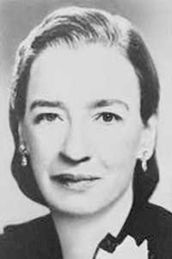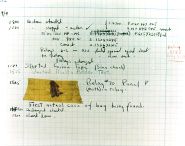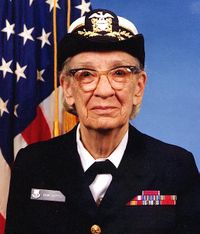Grace Hopper
From Wikipedia, the free encyclopedia
| Grace Murray Hopper | |
|---|---|
| (December 9, 1906 – January 1, 1992) | |
 Grace Hopper | |
| Place of birth | New York City |
| Service/branch | Navy |
| Years of service | 1943-1966, 1967-1971, 1972-1986. |
| Rank | Rear Admiral |
| Awards | Defense
Distinguished Service Medal Legion of
Merit |
Rear Admiral Grace Murray Hopper (December 9, 1906 – January 1, 1992) was an American computer scientist and United States Navy officer. A pioneer in the field, she was one of the first programmers of the Harvard Mark I calculator, and she developed the first compiler for a computer programming language.[1] Because of the breadth of her accomplishments and her naval rank, she is sometimes referred to as "Amazing Grace".
Contents |
[edit] Early life and education
Hopper was born Grace Brewster Murray in New York City. For her prep school education, Hopper attended the Hartridge School in Plainfield, NJ. She married Vincent Hopper in 1930 and was divorced in 1945. She graduated Phi Beta Kappa from Vassar College with a Bachelor's degree in mathematics and physics in 1928 and pursued her graduate education at Yale University, where she received a Master's degree in those subjects in 1930. In 1934 she received a Ph.D. in mathematics. Her dissertation was titled New Types of Irreducibility Criteria. Hopper began teaching mathematics at Vassar in 1931, and by 1941 she was an associate professor.
[edit] Mark I and Mark II calculators
In 1943 she joined the U.S. Naval Reserve on active duty and was assigned to work with Howard Aiken on the Mark I Calculator. At the end of the war she was separated from active duty with the Navy, remaining in the reserves, but she continued to work on the development of the Mark II and the Mark III calculators (early computers). It was while she was working on Mark II that she discovered a moth in a relay—a bug in the computer. Hopper noted it in a log book (now in the National Museum of American History at the Smithsonian Institution) as the first actual case of a bug being found.[2][3] Erroneously, some have cited this incident as the genesis of the term bug, but the term was already in wide use.
[edit] UNIVAC
In 1949, Hopper became an employee of the Eckert-Mauchly Computer Corporation and joined the team developing the UNIVAC I. In the early 1950s the company was taken over by the Remington Rand corporation and it was while she was working for them that her original compiler work was done. The compiler was known as the A compiler and its first version was A-0. Later versions were released commercially as the ARITH-MATIC, MATH-MATIC and FLOW-MATIC compilers.
[edit] COBOL
She later returned to the Navy where she worked on validation software for the programming language COBOL and its compiler. COBOL was defined by the CODASYL committee which extended her FLOW-MATIC language with some ideas from the IBM equivalent, the COMTRAN. However, it was her idea that programs could be written in a language that was close to English rather than in machine code or languages close to machine code (such as assembly language), which is how it was normally done at that time. It is fair to say that COBOL was based very much on her philosophy.
[edit] Standards
In the 1970s, she pioneered the implementation of standards for testing computer systems and components, most significantly for early programming languages such as FORTRAN and COBOL. The Navy tests for conformance to these standards led to significant convergence among the programming language dialects of the major computer vendors. In the 1980s, these tests (and their official administration) were assumed by the National Bureau of Standards (NBS), known today as the National Institute of Standards and Technology (NIST).
[edit] Retirement
Hopper retired from the Naval Reserve with the rank of Commander at the end of 1966. She was recalled to active duty in August of 1967 for a six-month period that turned into an indefinite assignment. She again retired in 1971 but was asked to return to active duty again in 1972. She was promoted to Captain in 1973 by Admiral Elmo R. Zumwalt, Jr.
After Rep. Philip Crane saw her on a March 1983 segment of 60 Minutes, he championed a joint resolution in the House of Representatives which led to her promotion to Commodore by special Presidential appointment.[citation needed] In 1985, the Naval grade of Commodore was renamed Rear Admiral, Lower Half. She retired (involuntarily) from the Navy on August 14, 1986. At a celebration held in Boston on the USS Constitution to celebrate her retirement, Hopper was awarded the Defense Distinguished Service Medal, the highest non-combat award possible by the Department of Defense. At the moment of her retirement, she was the oldest officer in the U.S. Navy and aboard the oldest ship in the U.S. Navy.
She was then hired as a senior consultant to Digital Equipment Corporation, a position she retained until her death in 1992, aged 85.
Her primary activity in this capacity was as a Goodwill Ambassador, lecturing widely on the early days of computers, her career, and on efforts that computer vendors could take to make life easier for their users. She visited a large fraction of Digital's engineering facilities where she generally received a standing ovation at the conclusion of her remarks. She always wore her Navy full dress uniform to these lectures.
She was laid to rest with full military honors in Arlington National Cemetery; Section 59, grave 973.[4]
[edit] Honors
- 1969 – She won the first "man of the year" award from the Data Processing Management Association.
- 1971 – The annual "Grace Murray Hopper Award for Outstanding Young Computer Professionals" was established in 1971 by the Association for Computing Machinery.
- 1973 – She became the first person from the United States and the first woman of any nationality to be made a Distinguished Fellow of the British Computer Society.
- 1986 – Upon her retirement she received the Defense Distinguished Service Medal.
- 1987 – She became a Computer History Museum Fellow Award Recipient.
- 1988 – She received the Golden Gavel Award at the Toastmasters International convention in Washington, DC.
- 1991 – She received the National Medal of Technology.
- 1996 – USS Hopper (DDG-70) was launched. Nicknamed Amazing Grace, it is on a very short list of U.S. military vessels named after women.
The Fleet Numerical Meteorology and Oceanography Center is located at 7 Grace Hopper Avenue in Monterey, California.
Grace Murray Hopper Park, located on South Joyce Street in Arlington, Virginia, is a small memorial park in front of her former residence (River House Apartments) and is now owned by Arlington County, Virginia.
Women at the world's largest software company, Microsoft Corporation, formed an employee group called "Hoppers" and established a scholarship in her honor. Hoppers has over 3000 members worldwide.
Brewster Academy, a school located in Wolfeboro, New Hampshire, USA, dedicated their computer lab to her in 1985, calling it the Grace Murray Hopper Center for Computer Learning. Hopper had spent her childhood summers at a family home in Wolfeboro.
An administration building on Naval Support Activity Annapolis (Previously known as Naval Station Annapolis) in Annapolis, Maryland is named "The Grace Hopper Building" in her honor.
[edit] Anecdotes

Throughout much of her later career, Grace Hopper was much in demand as a speaker at various computer-related events. She was well-known for her lively and irreverent speaking style, as well as a rich treasury of early "war stories".
- While she was working on a Mark II Computer at Harvard University, her associates discovered a moth stuck in a relay and thereby impeding operation, whereupon she remarked that they were "debugging" the system. Though the term computer bug cannot be definitively attributed to Admiral Hopper, she did bring the term into popularity. The remains of the moth can be found in the group's log book at the Smithsonian Institution's National Museum of American History in Washington, D.C..[2]
- Grace Hopper is famous for her nanoseconds visual aid. People (such as generals and admirals) used to ask her why satellite communication took so long. She started handing out pieces of wire which were just under one foot long, which is the distance that light travels in one nanosecond. She gave these pieces of wire the metonym "nanoseconds." Later she used the same pieces of wire to illustrate why computers had to be small to be fast. At many of her talks and visits, she handed out "nanoseconds" to everyone in the audience, contrasting them with a coil of wire nearly a thousand feet long, representing a microsecond. Later, while giving these lectures while working for DEC, she passed out packets of pepper which she called picoseconds.[5]
- The famous quotation "It's easier to ask forgiveness than it is to get permission" is often attributed to Grace Hopper.[6]
- Grace Hopper was very proud of her service in the United States Navy. She would often recount being mistaken, in airports, for an airline employee, because of her navy officers' uniform.
Obituary notices by:
- Betts, Mitch (Computerworld 26: 14, 1992)
- Bromberg, Howard (IEEE Software 9: 103–104, 1992)
- Danca, Richard A. (Federal Computing Week 6: 26–27, 1992)
- Hancock, Bill (Digital Review 9: 40, 1992)
- Power, Kevin (Government Computer News 11: 70, 1992)
- Sammet, J.E. (Communications of the ACM 35: 128–132, 1992)
- Weiss, Eric A. (IEEE Annals of the History of Computing 14: 56–58, 1992)
[edit] See also
[edit] References
- ^ Richard L. Wexelblat, ed. (1981). History of Programming Languages. New York: Academic Press. ISBN 0-12-745040-8.
- ^ a b Taylor, Alexander L., III. "The Wizard Inside the Machine", TIME, April 16, 1984. Retrieved on 2007-02-17.
- ^ Log Book With Computer Bug. National Museum of American History. Retrieved on 2007-02-17.
- ^ www.findagrave.com - Grace Murray Hopper.
- ^ www.hopper.navy.mil - Biography: Rear Admiral Grace Murray Hopper.
- ^ Diane Hamblen. Only the Limits of Our Imagination: An exclusive interview with RADM Grace M. Hopper. Department of the Navy Information Technology Magazine. Retrieved on 2007-01-31.
[edit] External links
- Biography and Images from the U.S. Navy Naval Historical Center
- Grace Hopper links from Chips, the U.S. Navy information technology magazine
- O'Connor, John J., and Edmund F. Robertson. "Grace Hopper". MacTutor History of Mathematics archive.
- A shorter Hopper biography, which unfortunately perpetuates the myth that she coined the term "computer bug".
- Biography and Wit and Wisdom from a Yale website
- http://www.gracehopper.org/ site for the annual Grace Hopper Celebration of Women in Computing
- http://www.hopper.navy.mil/ Official U.S. Navy website for the USS Hopper, which includes a biography of Hopper
- Rear Admiral Grace Hopper with pages about the lady and the ship named after her
- Grace Murray Hopper Award
- The Government Technology Leadership Awards: The Gracies
- Biography from the San Diego Supercomputer Center
- More details and photos from the moth/bug in the Mark II
- Grace Hopper at the Mathematics Genealogy Project
Categories: Articles with unsourced statements since February 2007 | All articles with unsourced statements | 1906 births | 1992 deaths | 20th century mathematicians | American military personnel of World War II | American computer programmers | American mathematicians | American people | American scientists | Burials at Arlington National Cemetery | Computer pioneers | National Medal of Technology recipients | People from New York City | Recipients of Distinguished Service Medal | Recipients of the Legion of Merit | United States Navy admirals | Vassar College alumni | Women computer scientists | Women in the United States Navy | Women in World War II | Women mathematicians



